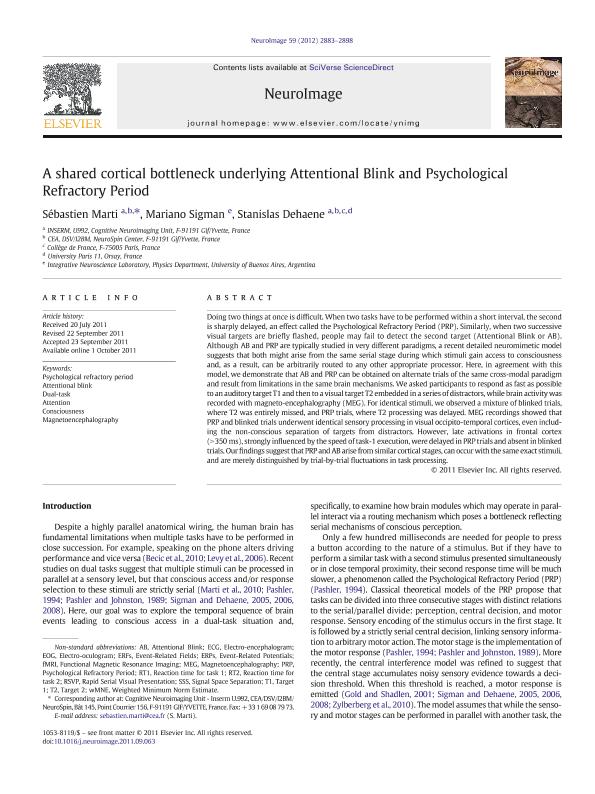Mostrar el registro sencillo del ítem
dc.contributor.author
Marti, Sébastien
dc.contributor.author
Sigman, Mariano

dc.contributor.author
Dehaene, Stanislas

dc.date.available
2018-08-24T16:38:51Z
dc.date.issued
2012-02
dc.identifier.citation
Marti, Sébastien; Sigman, Mariano; Dehaene, Stanislas; A shared cortical bottleneck underlying attentional blink and psychological refractory period; Academic Press Inc Elsevier Science; Journal Neuroimag; 59; 3; 2-2012; 2883-2898
dc.identifier.issn
1053-8119
dc.identifier.uri
http://hdl.handle.net/11336/56976
dc.description.abstract
Doing two things at once is difficult. When two tasks have to be performed within a short interval, the second is sharply delayed, an effect called the Psychological Refractory Period (PRP). Similarly, when two successive visual targets are briefly flashed, people may fail to detect the second target (Attentional Blink or AB). Although AB and PRP are typically studied in very different paradigms, a recent detailed neuromimetic model suggests that both might arise from the same serial stage during which stimuli gain access to consciousness and, as a result, can be arbitrarily routed to any other appropriate processor. Here, in agreement with this model, we demonstrate that AB and PRP can be obtained on alternate trials of the same cross-modal paradigm and result from limitations in the same brain mechanisms. We asked participants to respond as fast as possible to an auditory target T1 and then to a visual target T2 embedded in a series of distractors, while brain activity was recorded with magneto-encephalography (MEG). For identical stimuli, we observed a mixture of blinked trials, where T2 was entirely missed, and PRP trials, where T2 processing was delayed. MEG recordings showed that PRP and blinked trials underwent identical sensory processing in visual occipito-temporal cortices, even including the non-conscious separation of targets from distractors. However, late activations in frontal cortex (> 350 ms), strongly influenced by the speed of task-1 execution, were delayed in PRP trials and absent in blinked trials. Our findings suggest that PRP and AB arise from similar cortical stages, can occur with the same exact stimuli, and are merely distinguished by trial-by-trial fluctuations in task processing. © 2011 Elsevier Inc.
dc.format
application/pdf
dc.language.iso
eng
dc.publisher
Academic Press Inc Elsevier Science

dc.rights
info:eu-repo/semantics/openAccess
dc.rights.uri
https://creativecommons.org/licenses/by-nc-nd/2.5/ar/
dc.subject
Attention
dc.subject
Attentional Blink
dc.subject
Consciousness
dc.subject
Dual-Task
dc.subject
Magnetoencephalography
dc.subject
Psychological Refractory Period
dc.subject.classification
Otras Ciencias Biológicas

dc.subject.classification
Ciencias Biológicas

dc.subject.classification
CIENCIAS NATURALES Y EXACTAS

dc.subject.classification
Astronomía

dc.subject.classification
Ciencias Físicas

dc.subject.classification
CIENCIAS NATURALES Y EXACTAS

dc.title
A shared cortical bottleneck underlying attentional blink and psychological refractory period
dc.type
info:eu-repo/semantics/article
dc.type
info:ar-repo/semantics/artículo
dc.type
info:eu-repo/semantics/publishedVersion
dc.date.updated
2018-08-23T19:07:52Z
dc.journal.volume
59
dc.journal.number
3
dc.journal.pagination
2883-2898
dc.journal.pais
Países Bajos

dc.journal.ciudad
Amsterdam
dc.description.fil
Fil: Marti, Sébastien. Inserm; Francia. NeuroSpin Center; Francia
dc.description.fil
Fil: Sigman, Mariano. Consejo Nacional de Investigaciones Científicas y Técnicas. Oficina de Coordinación Administrativa Ciudad Universitaria. Instituto de Física de Buenos Aires. Universidad de Buenos Aires. Facultad de Ciencias Exactas y Naturales. Instituto de Física de Buenos Aires; Argentina
dc.description.fil
Fil: Dehaene, Stanislas. Inserm; Francia. NeuroSpin Center; Francia. Collège de France; Francia. Université de Paris XI; Francia
dc.journal.title
Journal Neuroimag

dc.relation.alternativeid
info:eu-repo/semantics/altIdentifier/doi/https://dx.doi.org/10.1016/j.neuroimage.2011.09.063
dc.relation.alternativeid
info:eu-repo/semantics/altIdentifier/url/https://www.sciencedirect.com/science/article/pii/S1053811911011372
Archivos asociados
